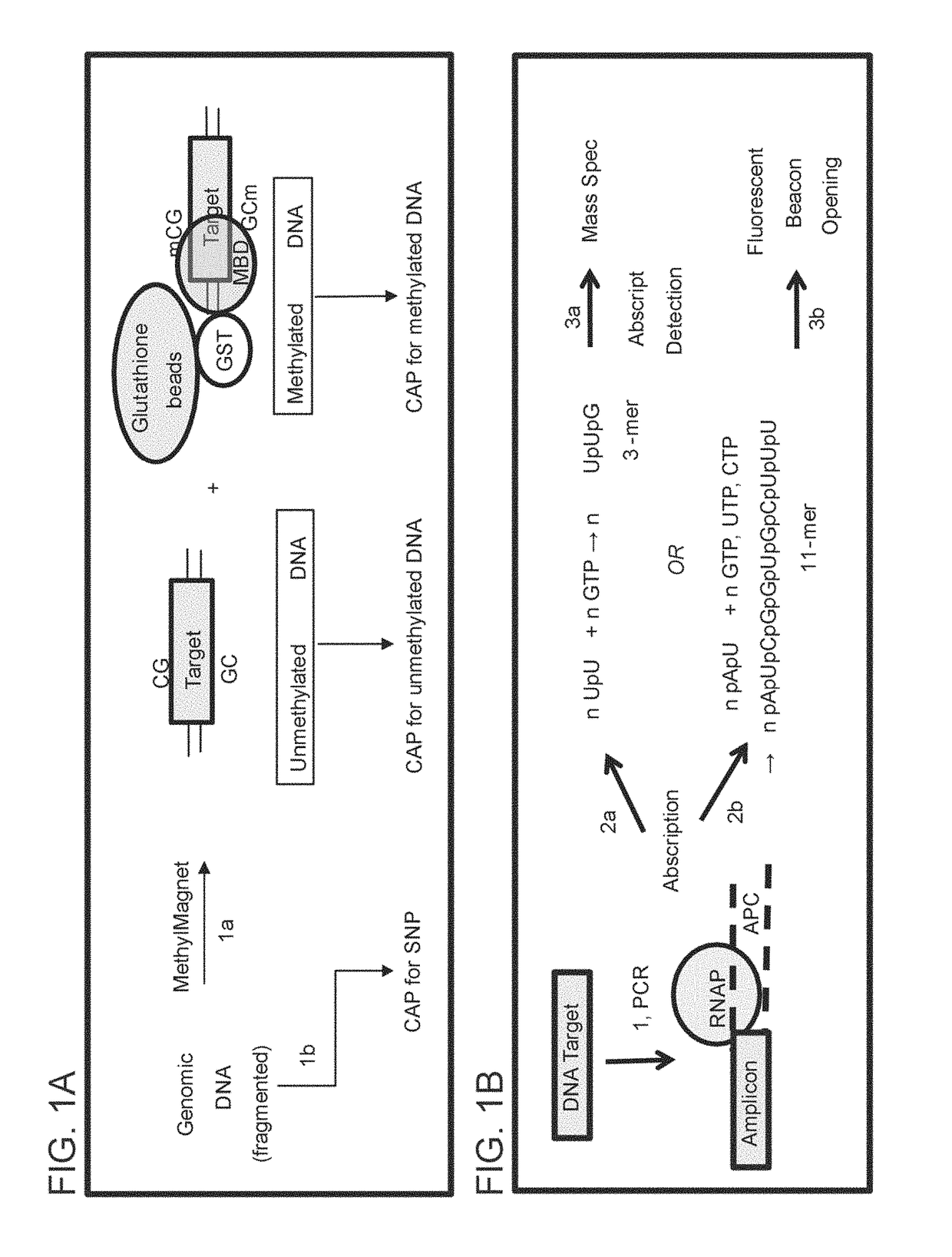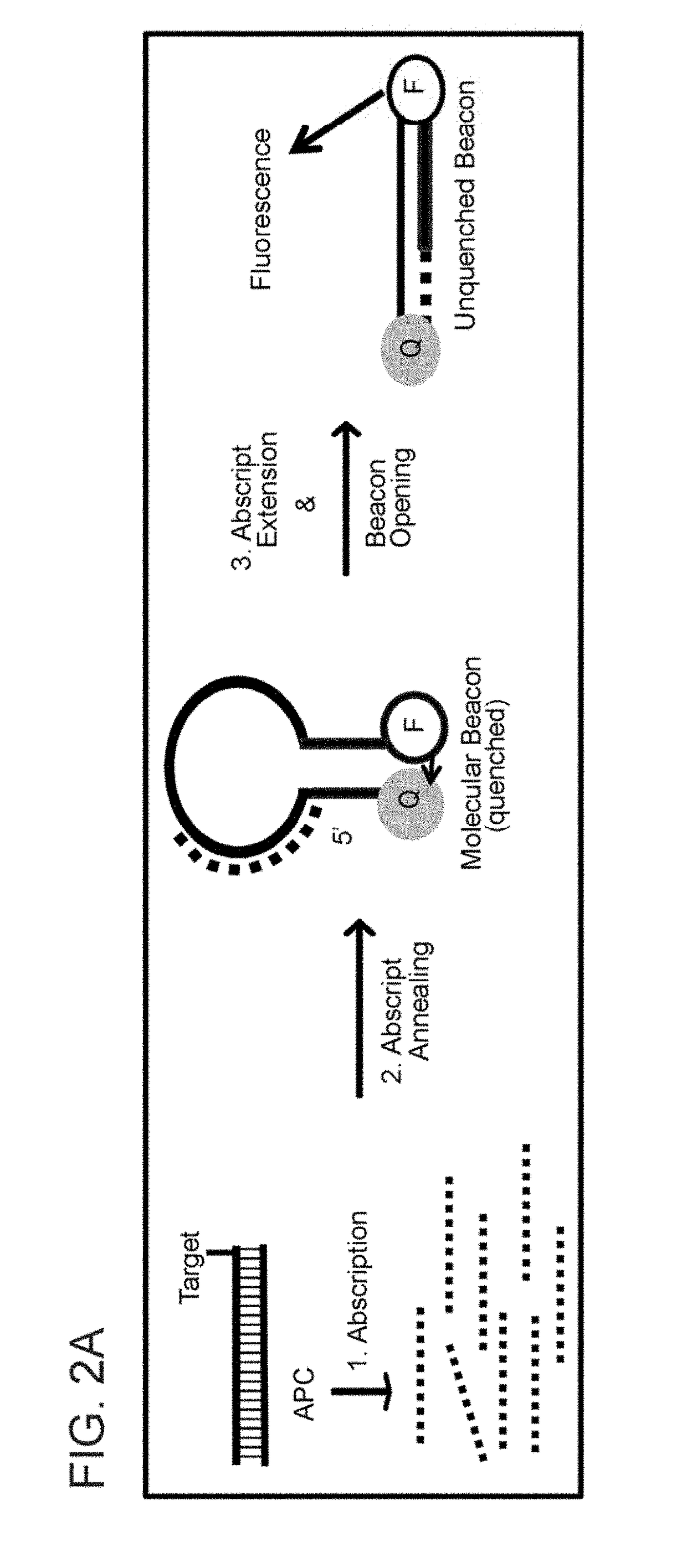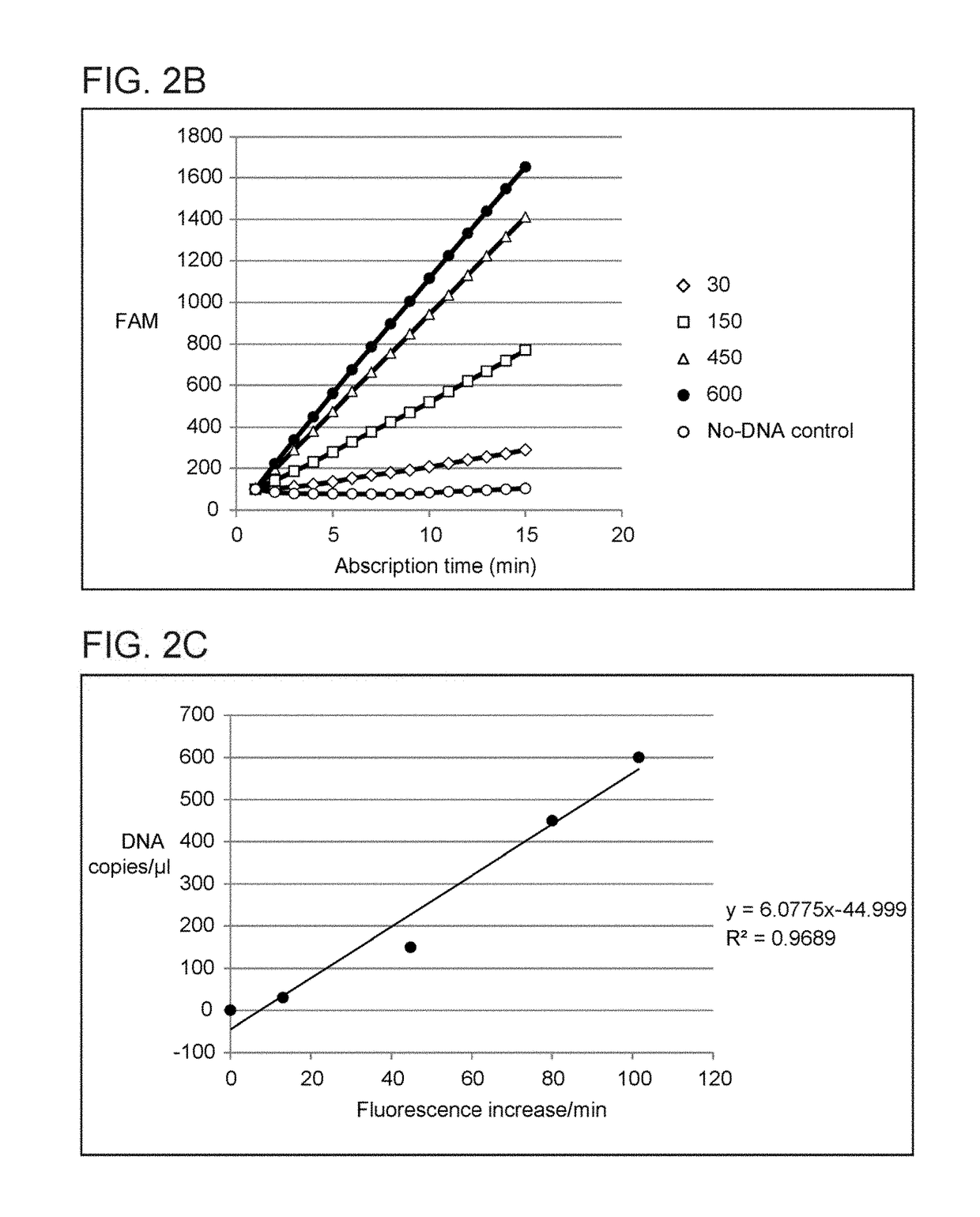ABORTIVE PROMOTER CASSETTES AND METHODS FOR FUSION TO TARGETS AND QUANTITATIVE CpG ISLAND METHYLATION DETECTION USING THE SAME
a promoter cassette and promoter technology, applied in the field of epigenetics and detection of diseases, can solve the problems of slow translation of these methods into clinical tests, high sensitivity of processing clinical samples, and limited sample sizes of clinical laboratories
- Summary
- Abstract
- Description
- Claims
- Application Information
AI Technical Summary
Benefits of technology
Problems solved by technology
Method used
Image
Examples
example 1
Amplification of the MLH1 CpG Island with a 4-Primer Set That Encodes an 11 nt Abscript
[0078]A segment of the MLH1 CpG island was amplified with a set of 4 primers that were designed as depicted in FIGS. 8A and 8B. HeLa genomic DNA (150 copies) was subjected to hot start PCR followed by Abscription under conditions where the Abscript contributes to the opening of a molecular beacon (FIG. 9). The first 3 PCR cycles were performed at 6 annealing temperatures to determine the most optimal conditions for the target specific primer sequences (FIG. 9, Legend). The last 27 cycles used an annealing temperature of 57.7° C. which was optimal for the APC completion primer and the universal reverse primer (FIGS. 8 A and 8B, primers C and D). Following target amplification, the PCR reactions were supplemented with Abscription reagents and were incubated at 40° C. for 20 min to synthesize an 11-nt long Abscript. FIG. 9 shows the signal as the slopes of fluorescence intensity verses Abscription ti...
example 2
Methylation Detection in FFPE Samples
Materials & Methods
Tissue & DNA Samples
[0079]Formalin Fixed Paraffin Embedded (FFPE) tissue sections from primary glioblastomas were obtained from the Austrian Institute of Technology (Vienna, Austria) and NuvOx Pharma (AZ, USA) and included tumors that had been assigned Grade II, III or IV via histopathology. Samples had been stored after fixation for between two months and 26 years before analysis. Tumor DNAs from frozen recurrent GBMs were provided by Tocagen Inc. (CA, USA).
DNA Purification From FFPE Tumor Sections
[0080]FFPE tissue sections were deparaffinized in xylene in two 5 min incubations. Solvent changes were made by centrifugation at 14,000×g for 5 min. Residual xylene was removed with a 100% ethanol wash. The tissue pellets were air dried and suspended in 50 mM Tris-HCl (pH 8.5 at 10 mM and 25° C.), 100 mM NaCl, 1 mM EDTA, 0.5% v / v Tween-20, 0.5% w / v NP40, 20 mM DTT and 500 μg / ml Proteinase K. The samples were incubated overnight at 5...
example 3
Methylation Detection in FFPE Samples
[0128]The following additional primer pairs summarized in Table 8, below, have been designed and validated for detection of methylation using the methods described herein.
TABLE 8Target-specific PrimersGene Symbol*DescriptionGene IDForwardReverseCDH1cadherin 19995′-APC-DN-GTCAGTT5′-UR-GAATGCGTCCC(SEQ ID NO: 46)CAGACTCCAGCC-3′TCGCAAGT-3′(SEQ ID NO: 25)(SEQ ID NO: 26)DAPK1death associated16125′-APC-DN-TCGGAGT5′-UR-GGAGGGAACAA(SEQ ID NO: 47)protein kinase 1GTGAGGAGGAC-3′AGTCCC-3′(SEQ ID NO: 27)(SEQ ID NO: 28)HOXA2homeobox A231995′-APC-DN-TTGTCCT5′-UR-CAGAACCCGGA(SEQ ID NO: 48)TGTCGCTCTGGT-3′AGCAAACA-3′(SEQ ID NO: 29)(SEQ ID NO: 30)KCTD5potassium544425′-APC-DN-TCTGAGT5′-UR-AGCTGTTCTGA(SEQ ID NO: 49)channelGATCGTGGTGCAG-3′GCCAAGCC-3′tetramerization(SEQ ID NO: 31)(SEQ ID NO: 32)domaincontaining 5MLH1mutL homolog 142925′-APC-DN-CTGGTTG5′-UR-TACCAGTGCAT(SEQ ID NO: 50)CGTAGATTCCTGTC-GGAGGTGTTGCT-3′3′(SEQ ID NO: 34)(SEQ ID NO: 33)RBRB59255′-APC-DN-ACTGTGA5′...
PUM
| Property | Measurement | Unit |
|---|---|---|
| Fraction | aaaaa | aaaaa |
| Fraction | aaaaa | aaaaa |
| Fraction | aaaaa | aaaaa |
Abstract
Description
Claims
Application Information
 Login to View More
Login to View More - R&D
- Intellectual Property
- Life Sciences
- Materials
- Tech Scout
- Unparalleled Data Quality
- Higher Quality Content
- 60% Fewer Hallucinations
Browse by: Latest US Patents, China's latest patents, Technical Efficacy Thesaurus, Application Domain, Technology Topic, Popular Technical Reports.
© 2025 PatSnap. All rights reserved.Legal|Privacy policy|Modern Slavery Act Transparency Statement|Sitemap|About US| Contact US: help@patsnap.com



